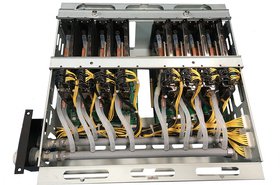Thanks to the Covid-19 pandemic, the retail industry will never be the same. And that’s not a bad thing. Before the pandemic, retailers were already investing in new technologies to modernize the shopping experience.
However, the pandemic, which forced temporary closures and reduced schedules, accelerated investments in technologies that had been talked about for years. Supporting the technologies at the forefront of modernizing the shopping experience is Edge computing.
Omnichannel: The future of retail is here
Central to the strategy of any retailer looking to modernize, regardless of company size, is the creation of a seamless experience for shoppers – the omnichannel.
It knocks down the barriers between online, mobile, and in-person shopping by allowing customers to initiate a purchase on one channel and finish using another. About two-thirds of e-commerce retailers in Europe and North America view omnichannel strategies as important.
This approach got a real boost during the pandemic with purchasing models such as BOPIS (buy online, pick up in-store) and curbside pickup.
These practices were implemented out of necessity while in-store shopping was paused, but now shoppers will continue expecting them. For instance, 50 percent of shoppers in a survey said they have decided whether to make an online purchase based on being able to pick it up in-store.
It’s no wonder then that omnichannel investments are a priority for the retail industry. However, it isn’t enough to simply make physical and digital channels seamless; retailers also recognize the need to transform their stores – to create an online-like experience when shoppers walk the aisles ticking items off their lists.
“Today’s shoppers have become accustomed to Amazon-like ecommerce experiences and are demanding more from the brick-and-mortar stores they frequent,” according to a recent MIT Technology Review article.
“From smart shelves and virtual dressing rooms to automated checkout options and staffing analytics, it’s clear that retail’s post-pandemic future will be powered by automated technologies that provide real-time results and meet rising expectations for a seamless shopping experience.”
But how exactly can retailers provide these digital-like experiences in their stores? They will undoubtedly require a significant investment in technology and infrastructure. A big part of the answer lies in Edge computing.
Edge computing infrastructure
Retail investments to create seamless omnichannel experiences include smart shelves that automatically track inventory for timely replenishment, automated checkouts with cameras that recognize produce, and handheld scanners for self-checkout.
In addition, many retailers are offering virtual dressing rooms that use digital mirrors that change the color of garments as shoppers try them on.
All of these technologies require real-time processing and analytics power that cloud infrastructures would typically be hard-pressed to deliver due to latency. This is why retailers, as they look to implement omnichannel strategies, also need to invest in Edge computing networks.
“To deliver on customer expectations for speed and flexibility, retailers need to bring the applications and the underlying processing and storage closer to where the data is being created.
“To do this at scale requires Edge computing, which can handle applications and workloads for thousands of store locations by running computational power through nearby network and storage equipment,” the MIT article explains.
Indeed, Edge computing sites located close to the point of sale (POS) can significantly enhance the customer experience.
For example, consider the practices of BOPIS or curbside pickup. With real-time data flowing between ordering systems, warehouse systems, and in-store order tracking and fulfillment, customers can be assured their items will be ready for pick up when they arrive at the store.
If, instead, a customer arrives and has to wait, say, 20 minutes for the item, the whole process starts to fall apart. Think of how frustrating it is to make a restaurant reservation and have to wait to be seated when you arrive on time.
With automation and omnichannel strategies, retailers can avoid these problems so long as they make the right investments. And that means implementing Edge networks that deliver the speed and capacity needed to make the omnichannel a reality.
Enable omnichannel strategies with Edge computing
Want to explore how edge computing can benefit your retail business? Check out Schneider’s Edge computing solutions page to learn more about the comprehensive solutions that enable digital transformation.
More from Schneider Electric
-

Schneider to sell Chilldyne direct-to-chip liquid cooling systems
Adds another cooling option to its arsenal
-

Sponsored Managed power services: Maximizing uptime and opening up the Edge
Examining the high-growth Edge (and revenue) opportunities made possible by managed power services
-

DCD>Talks resiliency with Pankaj Sharma, Schneider Electric
We sat down with Pankaj Sharma, Executive Vice President of the Secure Power Division at Schneider Electric, at our DCD connect event to talk about data center resiliency


